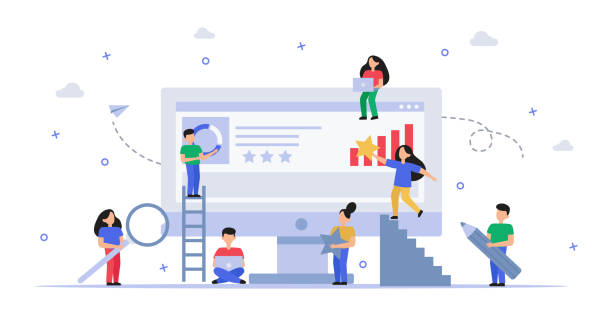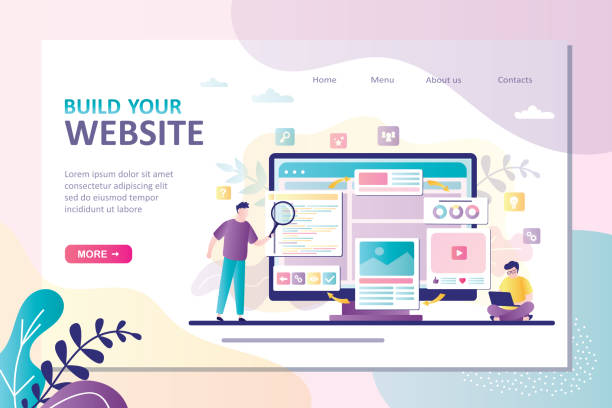Introduction to the Importance of Multilingual Website Design in the Global Age

In today’s world, where communication knows no borders and businesses are rapidly globalizing, merely having a website is not enough; a website is needed that can connect with audiences from diverse cultures and languages.
#Multilingual_Website_Design is no longer a luxury option, but a strategic necessity for any business looking to expand its global market.
This approach allows you to break down language barriers and provide a better user experience for your international audience.
Imagine a potential customer in Germany looking for your product or service, but your website is only available in Persian; most likely, they will turn to your competitors who offer their content in German.
This is where the importance of multilingual website design stands out as a powerful tool for attracting and retaining international customers, allowing you to speak to your audience anywhere in the world in their native language.
This not only increases customer trust and satisfaction but also helps improve the understanding of your brand message.
This article provides a comprehensive explanation of various aspects of multilingual website design, from initial planning and infrastructure selection to SEO considerations and user experience.
We will show you how to build a multilingual website that is not only technically sound but also culturally aligned with your target audience.
The localization process goes beyond mere translation; it involves adjusting content, images, currencies, date formats, and even humor to suit the local culture.
Understanding cultural nuances can be the difference between a successful website and one that is overlooked.
With proper implementation, your website can not only convey information but also establish an emotional connection with your international visitors and strengthen your digital presence globally.
We will also explore the competitive advantages of this approach, which include increased website traffic, improved conversion rates, and enhanced brand credibility at an international level.
This capability allows businesses to deliver their message in their customers’ native language, leading to greater trust and deeper engagement.
A multilingual platform also helps you achieve better rankings in local search engines and reach new audiences that would otherwise never encounter your site.
With this tutorial, you will not only become familiar with technical concepts but also gain a deeper understanding of the strategic and marketing dimensions of multilingual web design.
This is a smart investment in the future of your business that opens doors to new markets and provides significant growth potential.
This comprehensive approach prepares your website for success in the global arena and ensures you are one step ahead in global competition.
Are you annoyed by losing customers who have visited your site to make a purchase?
Rasav, your specialized solution for having a successful online store.
✅ Significant increase in your online sales
✅ Building trust and professional branding with customers⚡ Get free consultation from Rasav experts!
Prominent Challenges and Benefits of Multilingual Website Design

Multilingual website design, like any complex project, comes with its own set of challenges and benefits.
Understanding these before starting the project is crucial to its success.
One of the biggest advantages of having a multilingual website is the ability to access new and broader markets.
This allows businesses to grow beyond their current geographical boundaries and significantly increase their revenue.
Providing content in users’ native languages not only improves the user experience but also greatly enhances brand trust and credibility in the eyes of international audiences.
When users feel your website is designed for their needs, they are more likely to interact with your content and convert into customers.
This creates a thought-provoking content on whether your business is ready to embrace these changes and invest to achieve these benefits.
Furthermore, improving SEO rankings for various keywords in different languages attracts more organic traffic to your site, which is very valuable and cost-effective from a marketing perspective.
This competitive advantage distinguishes your business in international markets and increases your brand visibility.
But alongside the benefits, there are also challenges that need to be carefully managed.
Managing content translation and localization is one of the biggest challenges.
Maintaining the quality and accuracy of translations, and ensuring your message is correctly understood across different cultures, can be complex and time-consuming.
Using professional translators and Translation Management Systems (TMS) is essential in this regard to prevent machine translations that could harm your brand.
Another challenge is the technical issues related to SEO and URL structure, which must be carefully planned to avoid search engine penalties and maintain your rankings.
Furthermore, multilingual website design requires time and cost for maintaining and updating content in all languages; this includes updating text content, images, and even contact information and addresses.
Improper management of these aspects can lead to user dissatisfaction and decreased credibility.
From an analytical perspective, costs must be weighed against potential benefits.
Is the new target market large enough to justify the investment in multilingual site design? Do you have the necessary technical infrastructure and human resources to support this project? A thorough examination of resources and market potential is a vital step in the decision-making process.
Furthermore, cultural and legal impacts in each region must be considered.
Some countries have specific laws regarding data privacy or website content that must be adhered to.
Answering these questions will help you make decisions.
With careful planning, applying the right approaches, and a deep understanding of the associated complexities, these challenges can be turned into opportunities for growth and development, maximizing the significant benefits of an international website.
These essential steps ensure your success in the competitive global market.
Key SEO and Optimization Tips for Different Languages

SEO (Search Engine Optimization), for a multilingual website, requires a completely specialized and different approach.
You cannot simply translate content and expect it to rank high in search results.
Each language and geographical region has its own keywords, search habits, and even SEO competition.
One of the most important factors is the correct use of hreflang tags.
These tags help search engines like Google display the correct language version of your website to users in different geographical regions.
Incorrect use of these tags or their misuse can lead to issues such as duplicate content and lower your site’s ranking.
These tags play a vital role in directing users to the appropriate content, and errors in their implementation can nullify your efforts in multilingual website design, consequently harming user experience and your ranking in search results.
The next item is the URL structure, which must be carefully chosen.
Are you using subdomains (e.g., `fr.example.com`), subdirectories (e.g., `example.com/fr/`), or separate domains (e.g., `example.fr`)? Each has its advantages and disadvantages, and the appropriate choice depends on your goals and resources.
This is a very important guideline as it directly impacts how your site is crawled and indexed by search engines.
Also, site loading speed is crucial, especially for international users who may connect from slower internet connections or greater distances to the server; therefore, using Content Delivery Networks (CDN) and strong hosting close to your target audience can make a big difference in user experience and SEO ranking.
High-quality, localized content, which includes appropriate keyword research for each language, is also a key SEO factor and helps search engines understand the relevance of your content to local user searches.
The table below shows some of the main SEO considerations for multilingual website design:
| SEO Factor | Considerations for Multilingual | Importance |
|---|---|---|
| Hreflang Tags | Accurately determining language and geographical region for search engines | Very High |
| URL Structure | Choosing between subdomain, subdirectory, or separate domains | High |
| Keyword Research | Localized keyword research for each language | Very High |
| Site Loading Speed | Optimization for global users (CDN) | High |
| Localized Content | Quality translation and cultural localization | Very High |
| Internal Linking | Link to relevant pages in the same language | High |
| XML Sitemaps | Creating separate sitemaps for each language | Medium |
Finally, internal and external link building should also be carefully planned for each language.
Links from authoritative and relevant sites in each language can help improve SEO rankings.
This tutorial helps you properly optimize your site for a global audience and ensures your efforts in multilingual website design yield desired results in search engines.
Continuous optimization and performance monitoring in Google Search Console for each language version are also essential to quickly identify and resolve any potential issues.
Choosing the Best Strategy for Multilingual URL Structure

One of the fundamental and complex decisions in the planning phase of multilingual website design is choosing the appropriate URL structure.
This choice not only affects user experience but also has significant implications for SEO and long-term site maintenance.
There are three main options, each with its advantages and disadvantages, and their selection should be made considering the project’s goals and resources: subdirectories, subdomains, and separate domains.
In a specialized approach, all aspects must be carefully evaluated to make the best decision and lay the foundation for a successful multilingual website.
Subdirectories, such as `example.com/fr/` or `example.com/es/`, are usually the most popular option.
The main reason is their simplicity in implementation and management.
All content resides under a single main domain, which can help transfer the main domain’s authority to language versions.
This structure is generally favorable for SEO because search engines recognize these pages as part of a single, powerful domain, transferring the main site’s authority to the translated versions as well.
This concentrates link-building and SEO efforts for the entire site.
For guidance, this method is often recommended for small and medium-sized businesses looking for an efficient and cost-effective solution, as it does not require separate hosting or management of multiple domains and has less technical complexity.
Subdomains, such as `fr.example.com` or `es.example.com`, allow you to technically manage each language as a separate “site”.
This approach is suitable for larger organizations that may have different content teams for each region.
From an SEO perspective, search engines might consider each subdomain as a virtually independent entity, meaning the main domain’s authority may not be fully transferred to the subdomains.
This can mean needing separate SEO efforts for each subdomain, which can require more resources.
However, in some cases, for more precise geographical targeting and technical separation, subdomains are a good choice, especially if you plan to host each language version on a separate server or require specific server settings for each region.
Separate Domains or country code top-level domains (ccTLDs) like `example.fr` or `example.es`, provide the strongest geographical signal to search engines and clearly indicate that the site is targeted for a specific country.
This approach is highly suitable for large companies that have completely separate operations in different countries and want to establish strong branding in each country.
However, its disadvantages include higher costs for purchasing and managing multiple domains and the need for separate SEO and marketing for each domain.
This method is more expensive and complex but gives the best localization signal and can help build more trust in local markets, as users in that country feel that the website is entirely native and designed specifically for them.
Choosing a multilingual platform with appropriate infrastructure for each of these options is crucial to best leverage its benefits.
Ultimately, choosing the appropriate URL structure for multilingual website design depends on your business goals, budget, and technical resources.
It is important to consult with SEO experts before finalizing your decision and examine the advantages and disadvantages of each option within the specific context of your project.
This foundational decision forms the basis of your success in global markets and directly influences how your site is perceived by search engines and international users.
Are you concerned about your e-commerce site’s low conversion rate and not achieving your desired sales?
Rasav, your specialized solution for having a successful e-commerce website.
✅ Significant increase in conversion rates and sales
✅ Professional and user-friendly design to ensure customer satisfaction
⚡ Ready for a transformation in online sales? Get a free consultation!
Content Management and Professional Translation in Multilingual Websites

One of the most important pillars of success in multilingual website design is efficient content management and ensuring high-quality translations.
Mere word-for-word translation is not enough; content must be localized to align with the culture and sensitivities of the target audience in each language and accurately convey your brand message.
This tutorial helps you implement best practices in this area and prevent poor translations that could harm your reputation.
First, you need a Content Management System (CMS) that supports multilingual capabilities.
Many popular CMSs like WordPress (with plugins such as WPML or Polylang), Drupal, and Joomla provide the necessary features for this.
Choosing the right CMS greatly simplifies the process of creating, editing, and publishing content in different languages and allows you to manage content for each language separately.
Additionally, using Translation Management Systems (TMS) can help automate parts of the translation process and ensure consistency in terminology and brand tone.
These tools significantly increase efficiency, especially for large projects with a high volume of content.
The second point is the importance of hiring professional native translators.
Machine translation, though fast and cheap, usually lacks accuracy, cultural nuances, and appropriate tone.
A native translator not only knows the language but is also familiar with the culture, local idioms, popular keywords, and even social sensitivities in that market.
This ensures your message is accurately conveyed and prevents cultural misunderstandings.
This poses a thought-provoking question as to whether your organization is ready to invest in professional translation, as translation quality directly impacts your brand image.
Localization goes beyond mere translation.
It includes adjusting images, units (e.g., temperature, currency), date and time formats, and even colors to suit the tastes and cultural norms of local audiences.
For instance, the color red might symbolize love in one culture, while in another, it could indicate danger.
Also, colloquialisms or specific idioms might have different meanings or be entirely meaningless in other languages and require creative replacement.
This explanation demonstrates why localization is a complex but vital process requiring precision and deep cultural understanding.
Finally, creating a style guide and glossary for all languages significantly helps maintain consistency in tone, terminology, and branding.
This is especially important when multiple translators are working on your project to ensure all outputs adhere to a specific standard.
With careful planning and the use of appropriate resources, you can ensure that the content of your multilingual website, in all versions, is high-quality and effective, serving your business goals in the best possible way.
The Importance of User Experience (UX) in Multilingual Website Design

Multilingual website design is not just about translating content; it requires a complete overhaul of the User Experience (UX) for audiences from different cultures and languages.
A successful UX in a multilingual site allows users to easily find and select their desired language, and then have a smooth and familiar navigation experience that provides them with a sense of comfort and belonging.
This is an important guidance for designers to remember that design must go beyond words and address cultural needs and expectations.
The first point is to place language selection options in an accessible and clear location.
Typically, this option is placed in the site’s header or footer and is displayed as a dropdown menu, country flags (although flags might be misunderstood because one country can have multiple languages, or one language spoken in multiple countries), or the names of the languages in their native script (e.g., “English”, “Español”, “Deutsch”).
Choosing language names instead of flags is a better approach to prevent misunderstandings and provide greater clarity for users.
This is a specialized tip in design that directly impacts the ease of use of the site.
After selecting the language, it must be ensured that all site elements, including forms, buttons, error messages, images, and even text reading direction (for languages like Persian and Arabic that are right-to-left), are correctly localized.
This includes adjusting the width and height of elements to accommodate longer texts in specific languages (for example, German is often longer than English) to prevent layout distortion.
Also, fonts and colors must be carefully chosen to convey appropriate meaning in different cultures and provide the necessary readability.
Engaging content can also play a role in localization.
If you have content that relies on humor or specific cultural references, you must ensure these remain understandable and appealing in every language and culture.
Sometimes, a joke or cultural reference needs to be completely replaced so that the message is correctly conveyed and audiences do not feel alienated.
This demonstrates how much localization goes beyond simple translation and requires a deep understanding of the audience.
Finally, User Testing with native speakers for each version of the site is crucial.
This helps identify navigation, translation, or cultural issues that non-native developers or translators might not have noticed.
This is an important explanation about the importance of user feedback, which should be continuously collected and applied.
A good user experience in multilingual website design not only allows users to easily access information but also strengthens their sense of trust and satisfaction, turning them into loyal customers.
Suitable Hosting and Infrastructure for International Websites

Choosing the right hosting and infrastructure is one of the technical aspects of multilingual website design that is often overlooked, but it significantly impacts your site’s speed, performance, and SEO for a global audience.
Poor site performance due to unsuitable hosting can lead to high bounce rates and loss of visitors, even if your content is excellent.
This specialized section helps you make more informed decisions and prevent potential issues.
The first point is the physical location of the server.
If a significant portion of your audience is in Europe, choosing a server in Europe is more logical than a server in Asia.
The geographical distance between the user and the server affects the Ping and consequently the site loading speed.
For websites with a wide audience worldwide, using a Content Delivery Network (CDN) is almost a necessity.
CDN copies your website’s static content (such as images, CSS, JavaScript) to multiple servers worldwide, and when a user visits your site, the content is delivered from the closest server to them, which significantly increases loading speed.
This is especially vital for a multilingual platform whose traffic comes from various parts of the world.
Considering hosting reliability and scalability is also important.
A scalable hosting can easily increase its resources with traffic growth and prevent site downtime.
Also, 24/7 technical support and the hosting team’s technical knowledge regarding multilingual and international site issues are highly valuable, as you might encounter specific challenges like DNS settings for different domains or SSL issues in various regions.
The table below shows some of the considerations regarding hosting for multilingual website design:
| Hosting Feature | Importance for Multilingual Site | Description |
|---|---|---|
| Server Location | Very Important | Proximity to audience to reduce latency and improve UX |
| Use of CDN | Essential | Increasing loading speed for global users and reducing load on the main server |
| Scalability | High | Ability to increase resources with traffic growth and site needs |
| Technical Support | High | 24/7 access and technical knowledge regarding international and multilingual SEO issues |
| Security | Very High | Data protection against global threats and ensuring user trust |
| Hreflang Support | Medium | Ensuring host compatibility with proper implementation of language tags |
This is a comprehensive guide to ensure that your site’s infrastructure can support the traffic and needs of international users.
Choosing the right hosting can directly impact SEO and user experience, so this step should not be underestimated and must be carried out with sufficient care and foresight from the outset to prevent future problems.
Digital Marketing and Promotion for Global Markets

Upon completion of multilingual website design, the next stage is its marketing and promotion in global target markets.
The digital marketing strategy for a multilingual website goes far beyond running the same domestic campaigns in other languages.
Each market has its own unique needs, popular platforms, and media consumption habits.
Disregarding these differences can lead to wasted budget and failure to reach the target audience.
This news section provides you with information on the latest approaches and best practices for success in the international arena.
The first step is comprehensive market research for each target region.
This involves identifying native keywords, dominant digital marketing channels (such as Google, Baidu in China, Yandex in Russia, or local social networks), and a thorough understanding of competitors in each market.
PPC (Pay-Per-Click) advertising campaigns must be set up separately for each language and region, using localized keywords and ad texts that align with the tone and cultural expectations of that region.
Only with this approach can the maximum return on investment be achieved from advertising campaigns.
Content marketing also plays a vital role.
Blog content, articles, videos, and podcasts should not only be translated but also localized and aligned with the cultural interests and needs of local audiences.
A precise analysis of user behavior in each market can help you create relevant and engaging content.
For example, a success story in North America might not be as impactful in Japan and may require replacement with a local example.
This approach helps build deeper connections with audiences and directs them towards your multilingual website.
The use of social media must also be done with a localization approach.
Popular platforms in one country might be entirely different in another (e.g., WeChat in China, Line in Japan).
An active presence on local platforms and engaging with users in their language increases your brand’s credibility and helps attract traffic to your multilingual website.
This demonstrates your commitment to the local market and understanding of their needs.
Finally, email marketing and public relations (PR) must also be localized.
Sending personalized emails in users’ native languages and engaging with local media and influencers can help increase awareness and trust in your brand in new markets.
These comprehensive approaches and guidelines help you properly conduct your digital marketing for a multilingual website, achieve your global goals, and maintain a strong and sustainable presence in international markets.
Does your current corporate website not reflect your brand’s credibility and strength as it should? Rasav solves this challenge for you with professional corporate website design.
✅ Increased credibility and trust among visitors
✅ Targeted attraction of more customers
⚡ Click to get a free consultation!
Popular Tools and Plugins for Multilingual Website Design

To facilitate the process of multilingual website design and its management, numerous tools and plugins are available that can make the work much easier for developers and website administrators.
Choosing the right tools can save you time and costs and prevent technical and content-related issues.
This tutorial introduces some of the most commonly used ones to assist you in choosing the best solution for your project.
If your website is WordPress-based, WPML (WordPress Multilingual Plugin) and Polylang are two very popular and powerful options.
WPML is a comprehensive plugin that allows for the translation of posts, pages, categories, tags, menus, and even widgets.
This plugin is compatible with many other themes and plugins and also has built-in tools for multilingual SEO, making the management of hreflang tags easy.
Polylang is also a free and lighter option that allows you to manage your content in multiple languages, though it might require additional add-ons for some advanced features.
Both plugins are highly effective in transforming a WordPress site into a multilingual platform.
Similar tools also exist for other Content Management Systems like Drupal or Joomla.
Drupal 8 and its later versions have very powerful built-in multilingual capabilities that reduce the need for external plugins and provide seamless language management.
Joomla has also been designed with multilingual support from the outset and has built-in tools for this purpose.
These CMSs are suitable options for larger and more complex projects, offering high flexibility.
In addition to CMS plugins, Translation Management Systems (TMS) are also very useful for larger projects with a high volume of content.
Platforms like Transifex, PhraseApp (now part of Phrase Localization Suite), and Smartling allow you to manage the translation process from start to finish, coordinate translators, maintain Translation Memory and glossaries, and generally improve translation quality and speed.
These tools are essential for specialized and professional projects that require coordination among large teams of translators.
To ensure the correctness of multilingual SEO, tools like Screaming Frog SEO Spider can help you review hreflang tags and identify SEO-related issues.
Additionally, Google Search Console is essential for monitoring site performance in various markets and identifying localization errors.
By using these tools, you can monitor the performance of your multilingual website and carry out necessary optimizations.
These tools and plugins are an indispensable part of the design and management of a multilingual website, and by using them correctly, you can ensure that your site serves global audiences in the best possible way and achieves your business goals.
The Future of Multilingual Web Design and New Trends

The world of the web is rapidly evolving, and multilingual website design is no exception.
New trends and technological advancements, especially in the fields of Artificial Intelligence (AI) and Machine Learning (ML), are shaping the future of web design for global audiences.
These developments not only transform translation processes but also impact how users interact with websites and their overall experience.
This engaging and analytical section explores these developments to prepare you for the future.
One of the most important trends is the significant advancement in Neural Machine Translation (NMT).
Tools like Google Translate and DeepL, using neural networks, produce translations that increasingly approach human translation quality and can even better understand semantic and cultural nuances.
This means that in the future, the content translation process can become faster and cheaper, although human oversight will remain crucial to ensure accurate localization, preserve brand tone, and avoid strange errors that might affect brand credibility.
Human and machine translation will complement each other instead of competing.
Artificial intelligence can also play a role in personalizing the user experience on multilingual websites.
Imagine a site that can automatically detect a user’s language based on their location, browsing history, personal preferences, or even conversational tone, and display relevant, localized content to them.
This level of personalization significantly boosts user engagement and makes users feel the website is entirely designed for them.
AI-powered content recommendation systems can also suggest content appropriate for each culture.
Voice technologies are also growing and increasingly influencing how we interact with the web.
With the increasing popularity of voice assistants and voice search, multilingual websites must prepare themselves to respond to these types of interactions.
This includes optimizing content for voice responses and ensuring that information is correctly retrievable in different languages.
Websites should be able to answer user questions in their native language and provide information vocally as well.
Ultimately, multilingual website design will move towards more agile approaches.
By using automation tools and artificial intelligence, teams will be able to translate and publish content faster and respond to market changes and user needs with greater speed.
This means businesses can continuously grow in expanding global markets and take advantage of new opportunities.
The future of multilingual web design is exciting and full of potential for connecting more people worldwide and providing truly global and localized web experiences.
Frequently Asked Questions
| No. | Question | Answer |
|---|---|---|
| 1 | What is multilingual website design? | Multilingual website design means building a website whose content is available to users in several different languages. This is usually done through a simple user interface for switching languages. |
| 2 | Why should we design a multilingual website? | Multilingual website design helps you reach a larger audience worldwide, provide a better user experience for international users, and improve your global SEO. |
| 3 | What are the main methods for implementing multilingualism on a website? | The main methods include using subdomains, subdirectories, or URL parameters for each language, as well as using completely separate domains for each language. |
| 4 | For SEO, is it better to use a subdirectory or a subdomain? | From an SEO perspective, both subdirectory and subdomain methods can be effective. However, many SEO specialists prefer subdirectories due to better transfer of main domain authority. |
| 5 | What are the important points in translating multilingual website content? | Translation should be done by native translators, content should be localized in addition to translation to align with the target audience’s culture, and pure machine translation should be avoided. |
| 6 | What is the role of the hreflang tag in multilingual site SEO? | The hreflang tag helps search engines like Google display the correct language and regional version of a page to the appropriate users, which also prevents duplicate content issues. |
| 7 | Can a website be made multilingual without coding? | Yes, in Content Management Systems (CMS) like WordPress, powerful plugins such as WPML or Polylang exist that allow for multilingual website functionality without the need for coding. |
| 8 | What are the challenges of multilingual website design? | Challenges include translation management, content localization, adherence to SEO principles for each language, technical support for different languages, and ensuring design consistency across different languages. |
| 9 | What is the difference between translation and localization? | Translation is merely converting words from one language to another, whereas localization involves adapting content to the culture, customs, currency, date and time formats, and even appropriate colors for the target audience. |
| 10 | What is the best User Experience (UX) for language switching? | A clear and accessible language switcher (usually in the header or footer), using language names instead of flags (due to regional variations), and maintaining the user’s position after language change are important UX considerations. |
And other services of Rasav Advertising Agency in the field of advertising
Online advertising for USB microphones in digital directories
Introducing sellers of adapter cables on advertising platforms
Listing ads for laptop carrying bags on job sites
Sales ads for docking stations in commercial databases
Specialized advertising for gaming monitors in online directories
And over hundreds of other services in the field of internet advertising, advertising consulting, and organizational solutions
Internet Advertising | Advertising Strategy | Advertorials
🚀 Are you looking for a big leap in your online business? Rasav Afarin smooths your path to success by providing comprehensive digital marketing services including fast and professional website design, SEO, and social media management. With us, experience a powerful and impactful presence in the digital world.
📍 Tehran, Mirdamad Street, next to Central Bank, Southern Kazeroun Alley, Ramin Alley, No. 6

